A Passerine is any bird of the order Passeriformes from Latin (passer 'sparrow' and formis '-shaped'), which includes more than half of all bird species. Sometimes known as perching birds, passerines generally have an anisodactyl arrangement of their toes (three pointing forward and one back), which facilitates perching.
With more than 140 families and some 6,500 identified species, Passeriformes is the largest order of birds and among the most diverse clades of terrestrial vertebrates, representing 60% of birds. Passerines are divided into three clades: Acanthisitti (New Zealand wrens), Tyranni (suboscines), and Passeri (oscines or songbirds). The passerines contain several groups of brood parasites such as the viduas, cuckoo-finches, and the cowbirds. Most passerines are omnivorous, while the shrikes are carnivorous.
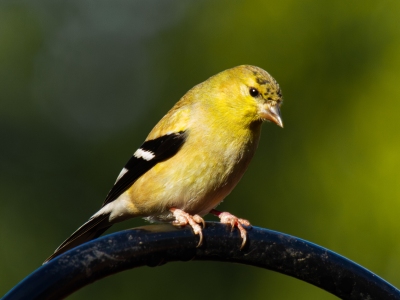 American Goldfinch
American Goldfinch The American Goldfinch (Spinus tristis) is a small North American bird in the finch family. It is migratory, ranging from mid-Alberta to North Carolina during the breeding season, and from just south of the Canada–United States border to Mexico during the winter.
The only finch in its subfamily to undergo a complete molt, the American goldfinch displays sexual dichromatism: the male is a vibrant yellow in the summer and an olive color during the winter, while the female is a dull yellow-brown shade which brightens only slightly during the summer. The male displays brightly colored plumage during the breeding season to attract a mate.
The American goldfinch is a granivore and adapted for the consumption of seedheads, with a conical beak to remove the seeds and agile feet to grip the stems of seedheads while feeding. It is a social bird and will gather in large flocks while feeding and migrating. It may behave territorially during nest construction, but this aggression is short-lived. Its breeding season is tied to the peak of food supply, beginning in late July, which is relatively late in the year for a finch. This species is generally monogamous and produces one brood each year.
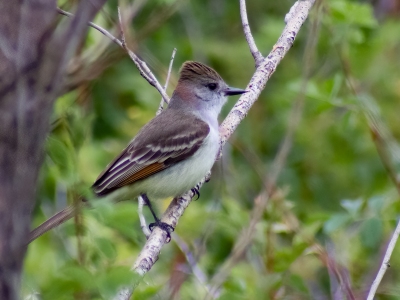 Ash-Throated Flycatcher
Ash-Throated Flycatcher The Ash-throated Flycatcher (Myiarchus cinerascens) is a passerine bird in the tyrant flycatcher family. It is a medium-sized tyrant flycatcher. Overall, it is slim and long-tailed, with a slightly peaked crest on its relatively large head. The upperparts are olive brown, with a darker head and short crest. The breast is gray and the belly is a very pale yellow. The brown tail feathers and wings have rufous outer webs, and there are two dull wing bars. The sexes are similar.
It breeds in desert scrub, riparian forest, brushy pastures and open woodland from the western United States to central Mexico. It is a short-distance migrant, retreating from most of the U.S. and northern and central Mexico, spending the winter from southern Mexico to Honduras. This bird is also prone to wander, with single birds often seen outside its normal breeding range as far away as the east coast of North America.
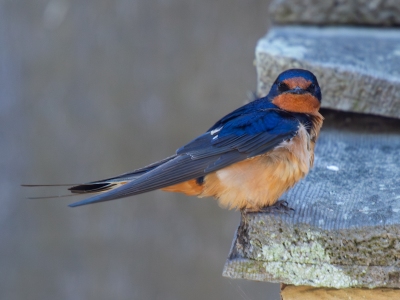 Barn Swallow
Barn Swallow The Barn Swallow (Hirundo rustica) is the most widespread species of swallow in the world, occurring on all continents, with vagrants reported even in Antarctica. It is a distinctive passerine bird with blue upperparts and a long, deeply forked tail. In Anglophone Europe, it is just called the swallow; in northern Europe, it is the only member of family <a href="https://en.wikipedia.org/wiki/Hirundinidae" class="mw-redirect"
The barn swallow is a bird of open country that normally nests in man-made structures and consequently has spread with human expansion. It builds a cup nest from mud pellets in barns or similar structures and feeds on insects caught in flight. This species lives in close association with humans, and its insect-eating habits mean that it is tolerated by humans; this acceptance was reinforced in the past by superstitions regarding the bird and its nest. There are frequent cultural references to the barn swallow in literary and religious works due to both its living in close proximity to humans and its annual migration. The barn swallow is the national bird of Austria and Estonia.
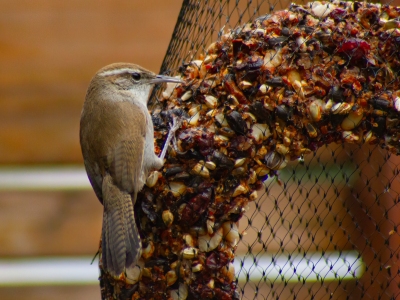 Bewick's Wren
Bewick's Wren The Bewick's wren (Thryomanes bewickii) is a wren native to North America. It is the only species placed in the genus Thryomanes. At about 14 cm (5.5 in) long, it is grey-brown above, white below, with a long white eyebrow. While similar in appearance to the Carolina wren, it has a long tail that is tipped in white. The song is loud and melodious, much like the song of other wrens. It lives in thickets, brush piles and hedgerows, open woodlands and scrubby areas, often near streams. It eats insects and spiders, which it gleans from vegetation or finds on the ground.
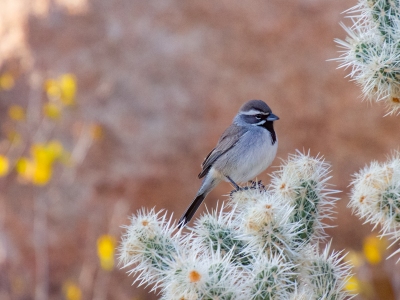 Black-Throated Sparrow
Black-Throated Sparrow The Black-throated Sparrow (Amphispiza bilineata) is a small New World sparrow primarily found in the southwestern United States and Mexico. It is the only member of the genus Amphispiza; the five-striped sparrow, formerly also classified in Amphispiza, is now thought to be in the monotypic genus Amphispizopsis.
It is sometimes referred to as the desert sparrow, due to its preferred habitat of arid desert hillsides and scrub. This name usually refers to the desert sparrow of Africa and Asia.
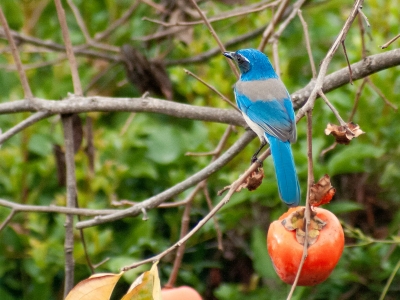 California Scrub Jay
California Scrub Jay The California scrub jay (Aphelocoma californica) is a species of scrub jay native to western North America. It ranges from southern British Columbia throughout California and western Nevada near Reno to west of the Sierra Nevada. The California scrub jay was once lumped with Woodhouse's scrub jay and collectively called the western scrub jay. The group was also lumped with the island scrub jay and the Florida scrub jay; the taxon was then called simply scrub jay. The California scrub jay is nonmigratory and can be found in urban areas, where it can become tame and will come to bird feeders. While many refer to scrub jays as "blue jays", the blue jay is a different species of bird entirely.
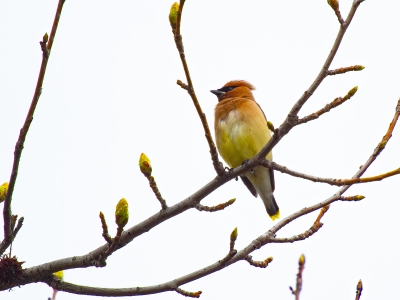 Cedar Waxwing
Cedar Waxwing The Cedar Waxwing (Bombycilla cedrorum) is a member of the family Bombycillidae or waxwing family of passerine birds. It is a medium-sized, mostly brown, gray, and yellow. This bird is named for its wax-like wing tips. It is a native of North and Central America, breeding in open wooded areas in southern Canada and wintering in the southern half of the United States, Central America, and the far northwest of South America. Its diet includes cedar cones, fruit, holly berries, and insects.
Preferred habitat consists of trees at the edge of wooded areas, or forests, especially those that provide access to berry sources as well as water. They are frequently seen in fruiting trees. Waxwings are attracted to the sound of running water and like to bathe in and drink from shallow creeks. In urban or suburban environments, waxwings often favor parkland with well-spaced trees;
golf courses, cemeteries, or other landscaping with well-spaced trees; bushes that provide berries; and a nearby water source such as a fountain or birdbath. Also look for them near farms, orchards, and gardens, particularly ones with fruiting trees or shrubs.
Cedar waxwings are sociable, seen in flocks year round. They are non-territorial birds and will often groom each other. They move from place to place depending on where they can find good sources of berries.
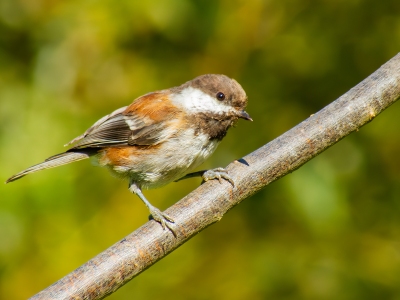 Chestnut-backed Chickadee
Chestnut-backed Chickadee The Chestnut-backed Chickadee (Poecile rufescens), formerly Parus rufescens, is a small passerine bird in the tit family, Paridae.
It is found in the Pacific Northwest of the United States and western Canada, from southern Alaska to southwestern California. It is a permanent resident within its range, with some seasonal movements as feeding flocks move short distances in search of food. They usually move to lower elevations in the same area upon onset of winter and move back up to higher elevations in late summer.
Its habitat is low elevation coniferous and mixed coniferous forests. In the San Francisco Bay Area this bird has readily adapted to suburban settings, prompting a range expansion. It is a cavity-nester, usually utilizing an abandoned woodpecker hole, but sometimes excavating on its own. Chestnut-backed chickadees use much fur and hair to make their nests. Their nests are actually 50% fur and hair. The most common hair they use comes from deer, rabbits, and coyotes. The adult chickadees also make a layer of fur about a centimeter thick which is used to cover the eggs on the nest whenever they leave the nest. It lays 5–8 (sometimes 9) eggs per clutch.
Its food is largely insects and other invertebrates gleaned from foliage. Chestnut-backed chickadees take some seeds, especially those of conifers, and fruit. It will visit bird feeders, including hummingbird feeders, and especially loves suet.
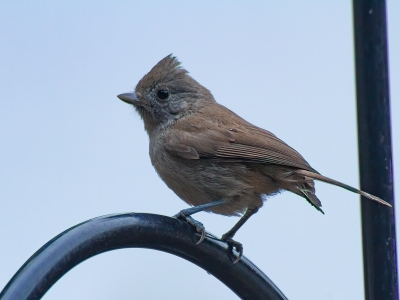 Oak Titmouse
Oak Titmouse The oak titmouse (Baeolophus inornatus) is a passerine bird in the tit family Paridae. The American Ornithologists' Union split the plain titmouse into the oak titmouse and the juniper titmouse in 1996, due to distinct differences in song, preferred habitat, and genetic makeup.
The oak titmouse is a small, brown-tinged gray bird with small tuft or crest. The face is plain, and the undersides are a lighter gray. Sexes are similar, as there is very little to no sexual dimorphism.
This species lives year-round on the Pacific slope, resident from southern Oregon south through California west of the Sierra Nevada to Baja California, but its range surrounds the central San Joaquin Valley. It prefers open woodlands of warm, dry oak and oak-pine at low to mid-elevations but can also be found in forests as long as adequate oak trees are present.
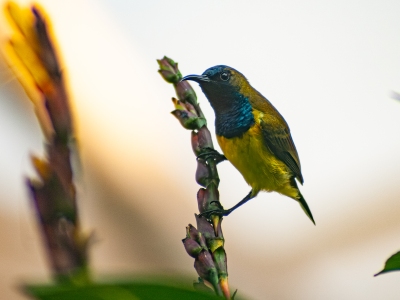 Olive-Backed Sunbird
Olive-Backed Sunbird The Olive-backed Sunbird (Cinnyris jugularis), formerly known as Olive-backed Sunbird, is a species of sunbird endemic to the Philippines except the Palawan island group.Subspecies obscurior is found in Northern Philippines (northern Luzon) while woodi is found in Sulu Archipelago, Southern Philippines. The nominate subspecies is foun in the rest of the range of the bird. Originally from mangrove habitat, the Garden Sunbird has adapted well to humans, and is now common even in fairly densely populated areas, even forming their nests in human dwellings.
The sunbirds are a group of very small Old World passerine birds which feed largely on nectar, although they will also take insects, especially when feeding young. Their flight is fast and direct on their short wings. Most species can take nectar by hovering, but usually perch to feed most of the time.
The sunbirds are a group of very small Old World passerine birds which feed largely on nectar, although they will also take insects, especially when feeding young. Their flight is fast and direct on their short wings. Most species can take nectar by hovering, but usually perch to feed most of the time.
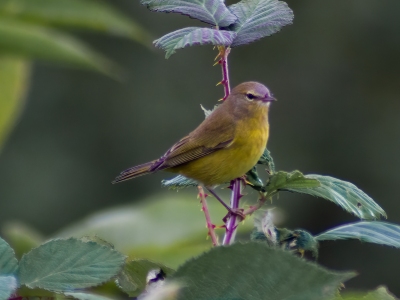 Orange-Crowned Warbler
Orange-Crowned Warbler The Orange-Crowned Warbler was formally described in 1822 by the American zoologist Thomas Say under the binomial name Sylvia celatus from a specimen collected on an expedition from Pittsburgh to the Rocky Mountains led by Stephen Harriman Long.
The orange-crowned warbler has olive-grey upperparts, yellowish underparts with faint streaking and a thin pointed bill. It has a faint line over each eye and a faint broken eye ring. The orange patch on the crown is usually not visible. Females and immatures are duller in colour than males. Western birds are yellower than eastern birds. Orange-crowned warblers are distinguished by their lack of wing bars, streaking on the underparts, strong face marking or bright colouring, resembling a fall Tennessee warbler and a black-throated blue warbler, both of which are also members of the New World warbler family.
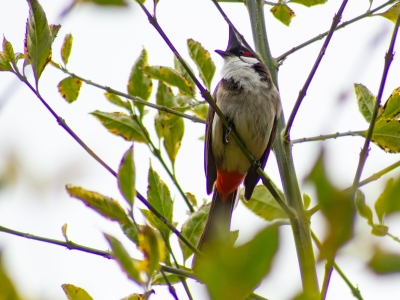 Red-whiskered Bulbul
Red-whiskered Bulbul The Red-whiskered Bulbul(Pycnonotus jocosus), or crested bulbul, is a passerine bird native to Asia. It is a member of the bulbul family. It is a resident frugivore found mainly in tropical Asia. It has been introduced in many tropical areas of the world where populations have established themselves. It has a loud three or four note call, feeds on fruits and small insects and perches conspicuously on trees. It is common in hill forests and urban gardens.
This is a bird of lightly wooded areas, more open country with bushes and shrubs, and farmland. Irruptions have been noted from early times with Thomas C. Jerdon noting that they were "periodically visiting Madras and other wooded towns in large flocks."
It has established itself in Australia and in Los Angeles, Hawaii, and Florida in the United States, as well as in Mauritius, on Assumption Island and Mascarene Islands. In Florida, it is only found in a small area, and its population could be extirpated easily. It was eradicated from Assumption Island in 2013–2015 to prevent colonisation of nearby Aldabra, the largest introduced bird-free tropical island.
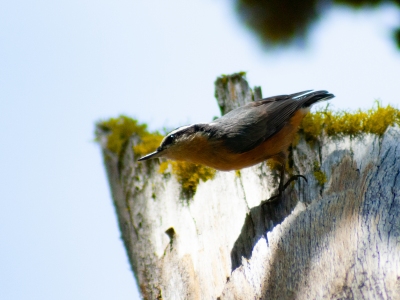 Red-Breasted Nuthatch
Red-Breasted Nuthatch The Red-Breasted Nuthatch (Sitta canadensis) is a small songbird. The adult has blue-grey upperparts with cinnamon underparts, a white throat and face with a black stripe through the eyes, a straight grey bill and a black crown. Its call, which has been likened to a tin trumpet, is high-pitched and nasal. It breeds in coniferous forests across Canada, Alaska and the northeastern and western United States. Though often a permanent resident, it regularly irrupts further south if its food supply fails. There are records of vagrants occurring as far south as the Gulf Coast and northern Mexico. It forages on the trunks and large branches of trees, often descending head first, sometimes catching insects in flight. It eats mainly insects and seeds, especially from conifers. It excavates its nest in dead wood, often close to the ground, smearing the entrance with pitch.
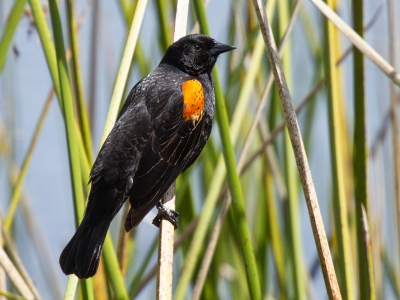 Red-WInged Blackbird - Mar, 2024 - El Capitan, CA
Red-WInged Blackbird - Mar, 2024 - El Capitan, CA The Red-Winged Blackbird (Agelaius phoeniceus) is a passerine bird of the family Icteridae found in most of North America and much of Central America. It breeds from Alaska and Newfoundland south to Florida, the Gulf of Mexico, Mexico, and Guatemala, with isolated populations in western El Salvador, northwestern Honduras, and northwestern Costa Rica. It may winter as far north as Pennsylvania and British Columbia, but northern populations are generally migratory, moving south to Mexico and the Southern United States. Claims have been made that it is the most abundant living land bird in North America, as bird-counting censuses of wintering red-winged blackbirds sometimes show that loose flocks can number in excess of a million birds per flock and the full number of breeding pairs across North and Central America may exceed 250 million in peak years. It also ranks among the best-studied wild bird species in the world. The red-winged blackbird is sexually dimorphic; the male is all black with a red shoulder and yellow wing bar, while the female is a nondescript dark brown. Seeds and insects make up the bulk of the red-winged blackbird's diet.
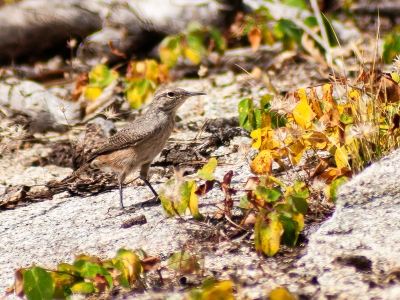 Rock Wren
Rock Wren The Rock Wren (Salpinctes obsoletus) is a small songbird of the wren family native to western North America, Mexico and Central America. It is the only species in the genus Salpinctes.
They have grey-brown upperparts with small black and white spots and pale grey underparts with a light brown rump. Additional distinctive features include a light grey line over the eye, a long slightly decurved thin bill, a long barred tail and dark legs. They actively hunt on the ground, around and under objects, probing with their bill as their extraction tool. They mainly eat insects and spiders. Its song is a trill that becomes more varied during the nesting season. These birds are permanent residents in the south of their range, but northern populations migrate to warmer areas from the central United States and southwest Canada southwards. They are occasional vagrants in the eastern United States. During the breeding season, they move to dry, rocky locations, including canyons, from southwestern Canada south to Costa Rica to build cup nests in a crevice or cavity, usually among rocks.
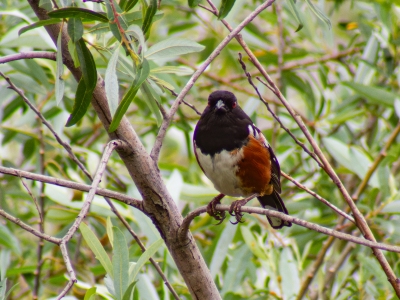 Spotted Towhee
Spotted Towhee The Spotted Towhee is a large New World sparrow, roughly the same size as a robin. It has a long, dark, fan-shaped tail with white corners on the end. It has a round body (similar to New World sparrows) with bright red eyes and dull pink legs.
The spotted towhee lives in dry upland forests, open forests, brushy fields, and chaparrals. It breeds across north-western North America and is present year-round in California, Nevada, Arizona, Utah, Oregon, Washington, Idaho and southern British Columbia.
These birds forage on the ground or in low vegetation, with a habit of noisily rummaging through dry leaves searching for food. During the breeding season (spring and summer) they mainly eat insects, ground dwelling beetles, spiders and other arthropods that reside in the leaf litter that is foraged by the spotted towhee. They only eat protein rich food in the breeding season, and in the fall and winter they focus on foraging for acorns, seeds oats and berries. They will frequent bird feeders if present in their woodland habitat.